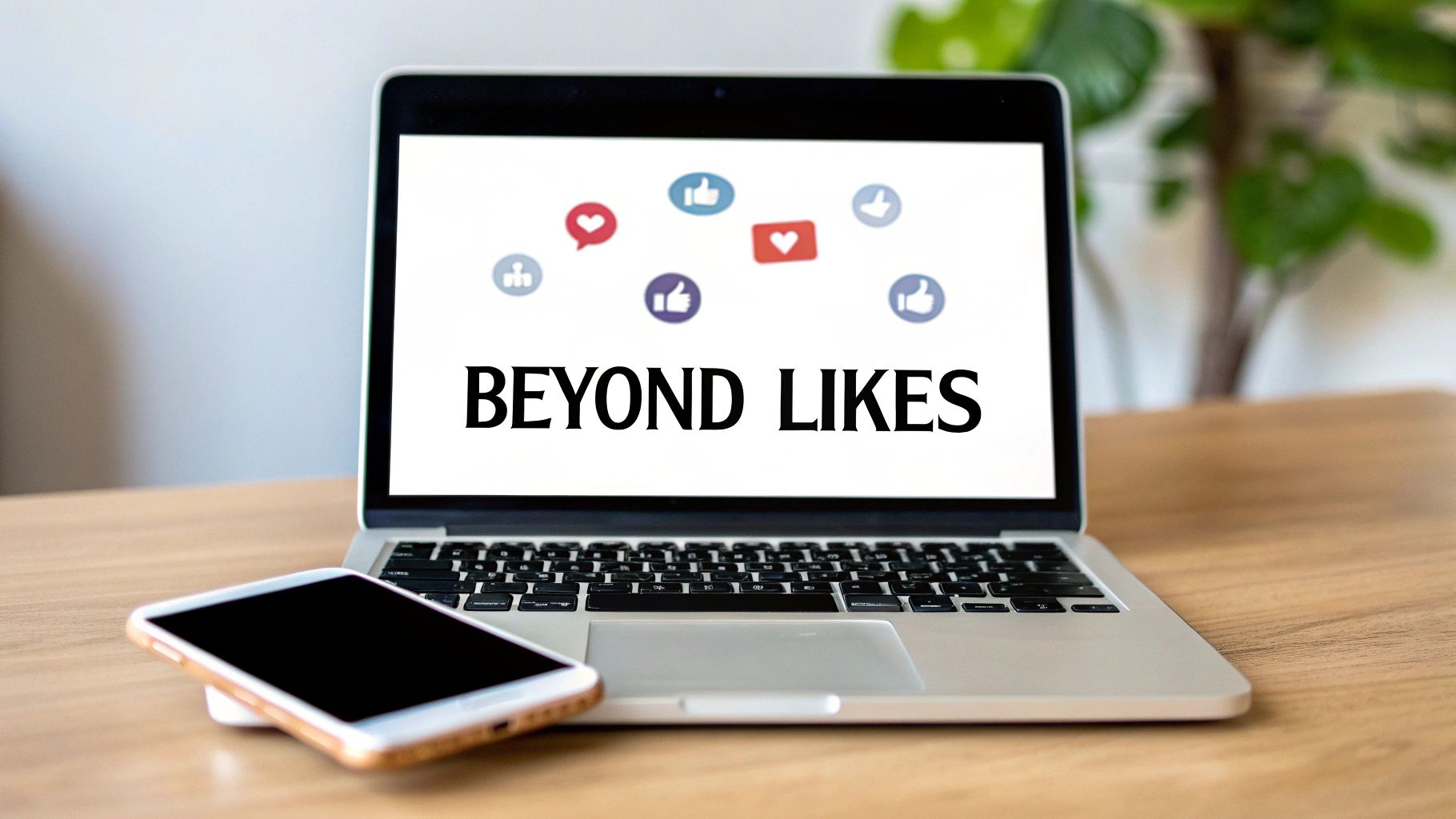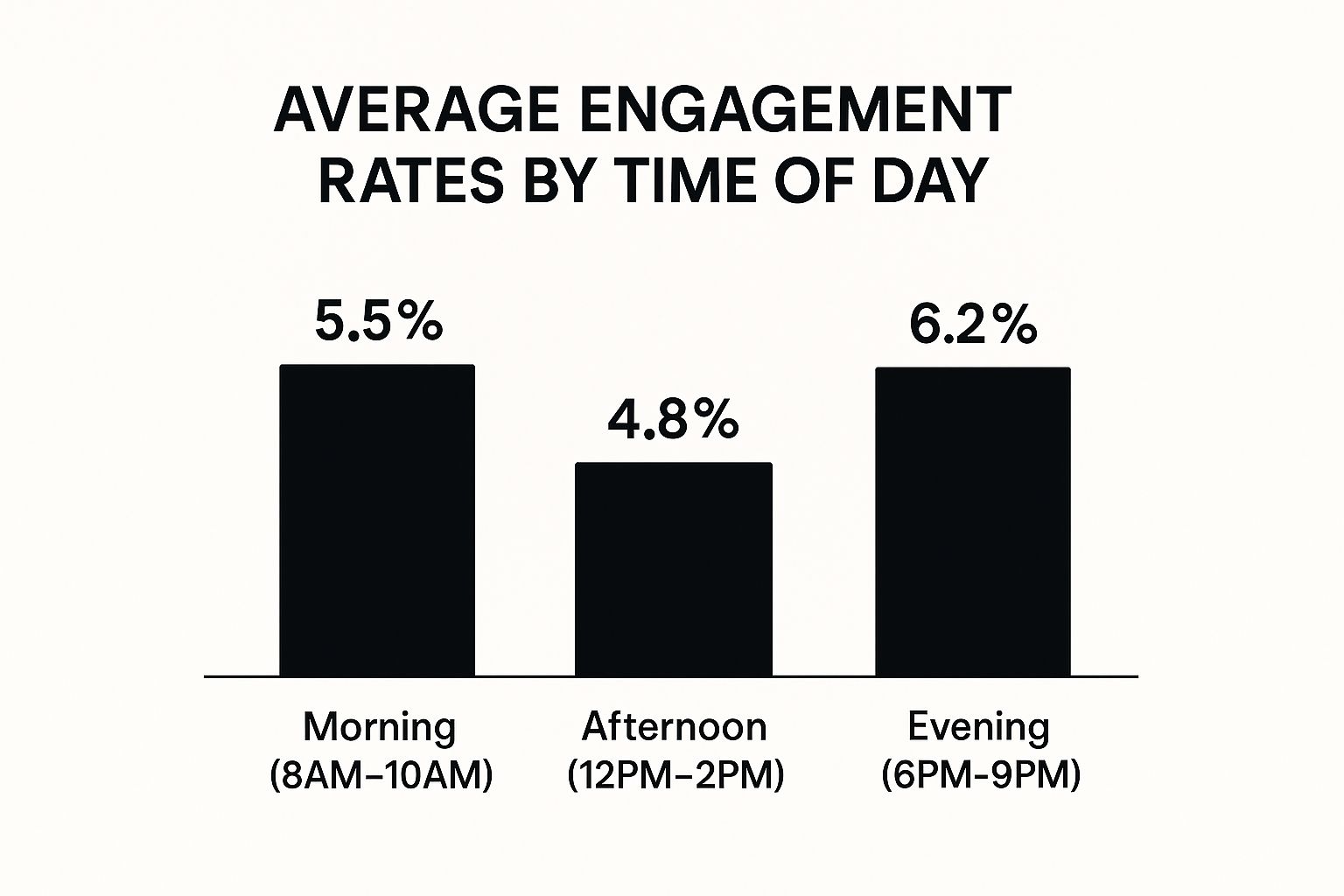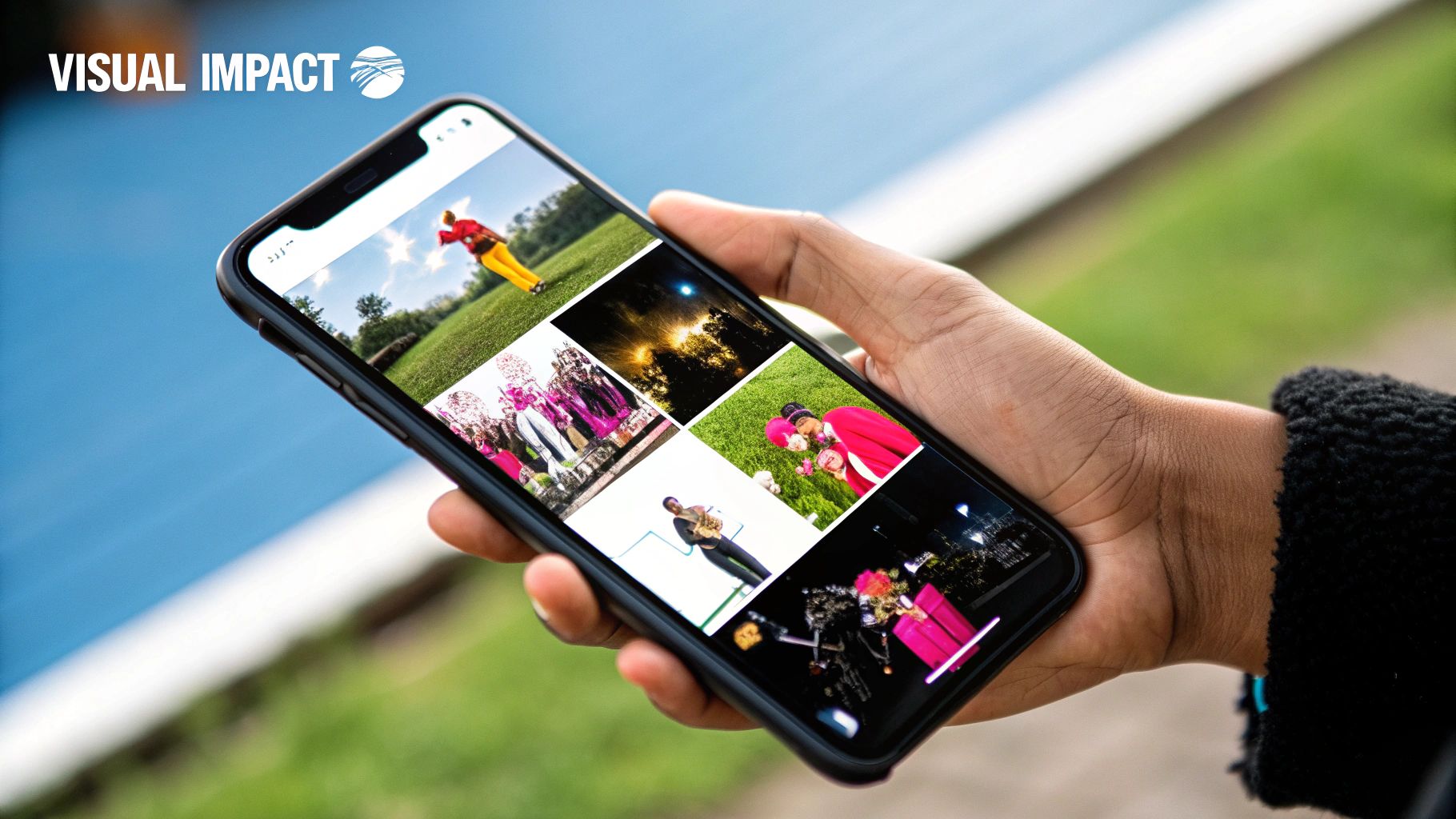How to Improve Social Media Engagement Beyond Likes
Learn effective strategies on how to improve social media engagement and boost your online presence. Discover actionable tips today!

It's time to stop just talking at your audience and start talking with them. True social media engagement isn't about broadcasting your message into the void; it's about sparking real conversations and building a community. That means shifting your focus from easy-to-get likes to the interactions that actually matter: saves, shares, and thoughtful comments.
Moving Beyond Likes to Meaningful Engagement

For a long time, we were all conditioned to chase the like count as the ultimate sign of success. But let's be honest, that model is broken. Real engagement isn’t a passive double-tap. It's an active signal that your content connected so well that someone felt compelled to save it, share it with their friends, or take a moment to type out a genuine response. These are the actions that build brand loyalty.
This is more important than ever. You're competing for attention against a flood of content, with over 5.45 billion people scrolling through social media for almost two and a half hours every single day. They're looking for everything from family updates to inspiration for their next purchase, so your content needs to cut through the noise and serve a real purpose.
Redefining Your Key Performance Indicators
If you want to genuinely boost your engagement, you have to start by measuring what counts. Chasing likes is like aiming for polite applause at the end of a show. What you really want is a standing ovation—that’s the sign you’ve made a real connection.
Let’s look at the metrics that actually show your audience is paying attention.
It’s easy to get lost in the data, but not all metrics are created equal. The table below breaks down which numbers tell a story of real connection versus just surface-level visibility.
Engagement Metrics That Actually Matter
| Metric Type | Examples (Likes, Follows) | Impact Level | Why It Matters |
|---|---|---|---|
| Vanity Metrics | Likes, Follower Count, Impressions | Low | These show reach but not genuine interest. A high number looks good but doesn't guarantee an active audience. |
| Audience Engagement | Comments, Shares | Medium | Shares extend your reach organically, while comments open the door for conversation. They show people are interacting. |
| High-Intent Actions | Saves, Link Clicks, DMs | High | These are strong indicators of interest and trust. Saves mean your content is valuable, while clicks and DMs show a desire to learn more or connect directly. |
| Conversion Metrics | Leads, Sales, Sign-ups | Very High | This is the bottom line. These metrics directly tie your social media efforts to tangible business results. |
Ultimately, focusing on high-intent and conversion metrics gives you a much clearer picture of your ROI and helps you create content that your audience truly values.
So, your new key performance indicators (KPIs) should reflect this deeper level of interaction. Start focusing on things like:
- Saves: This tells you the content was so useful or inspiring that someone wants to come back to it later. It's a digital bookmark.
- Shares: A share is a personal endorsement. Someone is putting their own reputation on the line to show your content to their network. That's powerful.
- Comment Quality: Look past the "great post!" comments. Are people asking questions? Are they sharing their own stories or tagging friends who would find it useful? That's where the magic happens.
- Direct Messages (DMs): When someone slides into your DMs, it’s a private, one-on-one conversation. It signifies a high level of trust and genuine interest.
By zeroing in on these high-intent actions, you’re no longer just trying to be seen—you’re trying to be remembered. This is how you turn passive followers into your biggest fans.
Getting this part right is the first step. For creators looking to build a powerful online presence, understanding these metrics is non-negotiable. It's a foundational shift that sets you up for all the actionable strategies that come next. You can learn more about how to build these deep connections at https://createinfluencers.com/.
Crafting Content That Sparks Real Conversation

Let’s be honest: creating content that people feel compelled to respond to is a mix of art and science. It’s about ditching the corporate announcements and sterile promotions for posts that actually start a real chat. The whole point is to make your followers feel seen and heard—so much so that they actually want to share their thoughts.
This means you’ve got to ask the right questions, tap into real emotions, and build a space where chiming in feels totally natural. Once your content starts inviting people to participate instead of just screaming for their attention, you'll see a massive change in the quality of your engagement.
Ask Questions That Demand More Than a "Yes" or "No"
Nothing kills a conversation faster than a question with a one-word answer. "Do you like our new product?" is a dead end. Instead, you need to frame questions that beg for a story, an opinion, or a little personal reflection. This is a fundamental part of learning how to improve social media engagement.
Just think about the difference here:
- Weak Question: "Ready for the weekend?"
- Strong Question: "What’s one thing you’re doing this weekend to recharge? We’re looking for ideas!"
The second one opens the door for genuine answers, gives your audience a reason to comment, and even gives you some great insights into their lives. The trick is to show you’re actually curious.
When you ask better questions, you get better answers. Frame your prompts to encourage storytelling and personal opinions, transforming your comments section from a ghost town into a bustling community forum.
Turn Your Audience Into Content Creators
User-generated content (UGC) is one of the most effective tools you have for boosting engagement. It’s authentic, builds incredible trust, and literally makes your community members the heroes of your brand’s story. When someone posts a picture with your product, they're giving you their most powerful endorsement.
You can encourage this by creating a branded hashtag and consistently featuring the best submissions. But don't just repost their photo—celebrate them in the caption! For creators and influencers, this strategy is pure gold. You can find more specific methods to inspire your followers in our detailed guides: https://createinfluencers.com/guides.
For example, a local coffee shop could run a weekly "#MyMorningMug" feature, showcasing the best customer photos. This gives them an endless stream of authentic content and motivates others to join in for their own chance in the spotlight. It's a win-win.
Weave Stories That Connect on an Emotional Level
Facts tell, but stories sell. On social media, stories are what truly connect us. People will remember how you made them feel long after they forget the specific details of a post. Storytelling creates an emotional bond that a simple product shot just can't compete with.
Share the "why" behind your brand. Talk about the struggles, celebrate the breakthroughs, and introduce the people who make it all happen. This is what humanizes your brand and gives your followers something to root for.
A perfect example is sharing a behind-the-scenes look at how a product is made or telling the story of a customer who had a life-changing experience. These narratives are relatable and shareable, which is exactly what you need to boost engagement. To really nail this, you need to understand the basics of how to create engaging content.
Make Interaction Irresistible
Finally, you have to use the interactive tools that the platforms give you. These features were designed specifically to increase engagement, so ignoring them is just leaving opportunity on the table.
- Instagram & Facebook Stories: Get in the habit of using polls, quizzes, and question stickers every day. They're super low-effort for your followers to engage with and give you instant feedback.
- Live Video: Host Q&A sessions, tutorials, or behind-the-scenes tours. The real-time nature of live video is fantastic for encouraging immediate comments and questions.
- Interactive Polls on LinkedIn: Spark a professional debate or gather some industry insights with a simple poll. It's an incredibly effective way to get your network talking.
When you start using these techniques consistently, your content will shift from a one-way monologue to a dynamic dialogue. You won't just see your metrics climb; you'll build a genuinely loyal and active community around your brand.
Mastering Platform-Specific Engagement Tactics
Treating all your social media channels the same way is a recipe for disaster. It's like trying to have the exact same conversation at a family barbecue, a professional networking event, and a loud concert—it just won't work. To get real engagement, you have to understand that each platform is its own world with unique rules, cultures, and user expectations.
What goes viral on TikTok might get you crickets on LinkedIn. A beautifully curated photo that shines on Instagram could feel completely out of place on Reddit. Nailing these nuances is what separates brands that thrive from those that just shout into the void.
Instagram And TikTok: The Visual And Trend-Driven Powerhouses
Instagram has moved far beyond just static photos. Today, the platform's heartbeat is video, especially Reels. The algorithm absolutely loves them, making them perfect for showing off tutorials, behind-the-scenes content, or just telling a quick, compelling story.
- Go All-In on Reels: Don't just post a video. Jump on trending audio and use popular effects to get your content in front of new eyes. A simple "day in the life" Reel set to a hit song can easily outperform a meticulously staged photo.
- Use Collaborative Posts: This is a game-changer. You can co-author a post with another account, instantly sharing it with both of your audiences. It's one of the most effective ways to cross-promote and tap into new communities.
- Make Your Stories Interactive: Don't forget about Story stickers. Polls, quizzes, and question boxes are incredibly simple ways for your audience to engage, giving you instant feedback while signaling to the algorithm that people are interacting with your content.
TikTok, on the other hand, is driven by authenticity and cultural trends. Users there have a sixth sense for spotting brands that are trying too hard. The key isn't just to copy a trend, but to make it your own. Find a trending sound or a popular format that genuinely fits your brand's personality and give it a unique spin.
LinkedIn: The Hub For Professional Dialogue
Just because LinkedIn is a professional network doesn't mean your content has to be stiff and boring. Engagement here isn't about flashy visuals; it's about sparking insightful conversations, sharing real expertise, and telling relatable career stories.
Think of it like you're at an industry conference. You wouldn't just stand in a corner holding a sign with your logo on it, right? You'd join discussions, offer your unique perspective, and build genuine connections.
On LinkedIn, the goal is to be a thought leader, not just a content publisher. Spark a debate with a thought-provoking question, share a valuable lesson you learned from a professional failure, or break down a complex industry topic into a simple, easy-to-understand post.
For example, a B2B software company shouldn't just announce a new feature. A much better approach would be to post about the frustrating industry problem their new feature solves, then ask their network how they've dealt with similar challenges. This opens the door for conversation and positions the brand as a helpful expert. For more inspiration on building these kinds of stories, check out our collection of creator-focused articles on the blog.
This chart gives a great overview of when users are most active, which can be a huge help when scheduling your content.

As you can see, activity often spikes in the evening. That’s a crucial piece of information to have when you're planning posts for a professional audience on a platform like LinkedIn.
To help you visualize these differences, here’s a quick breakdown of how to approach each platform for the best results.
Platform Engagement Strategy Comparison
| Platform | Optimal Content Type | Key Engagement Tactic | Audience Expectation |
|---|---|---|---|
| High-quality Reels, Carousels, Stories | Use trending audio, interactive stickers, visual storytelling | Aesthetically pleasing, entertaining, and educational content. | |
| TikTok | Short-form, trend-based videos | Participate in challenges, use humor, be authentic | Raw, unpolished, and highly creative content that feels native. |
| Text-based posts, articles, polls | Ask insightful questions, share career stories, offer industry analysis | Professional advice, industry news, and valuable thought leadership. | |
| Text posts, AMAs, memes (in relevant subreddits) | Add value to conversations before promoting, become a community member | Genuine participation, expertise, and niche-specific humor. No hard selling. | |
| Threads | Short text updates, questions, quick thoughts | Engage in real-time conversations, be conversational and witty | Casual, unfiltered dialogue and quick interactions; less polished than Instagram. |
This table really highlights that there's no single "best" way to post. Success comes from respecting the unique environment of each platform and showing up in a way that feels natural to the users there.
Reddit And Threads: The Community-First Frontiers
On platforms like Reddit and Threads, the community is everything. Blatant self-promotion is the fastest way to get downvoted or completely ignored. To succeed here, you have to provide real value and build trust before you ever think about asking for something.
The social media world is always in motion, and we're seeing a big shift toward these conversation-first apps. While giants like Facebook and Instagram aren't going anywhere, newer platforms like Threads saw explosive growth after its 2023 launch, proving that users are hungry for community-driven spaces. This is especially true during major world events, when people flock to Reddit, X, and Telegram for real-time discussions.
On Reddit, your first step is to find the right subreddits where your audience is already hanging out. Don't just drop a link to your website and run. Stick around. Answer questions, share your expertise, and become a helpful, recognized member of the community. Here, engagement is something you earn through genuine participation.
Threads works in a similar way. It’s a fast-paced, text-based platform for real-time chats. Use it to share quick takes, ask your followers questions, and engage directly in a much more casual and unfiltered style. In these spaces, your authenticity is your most valuable currency.
Building and Nurturing Your Online Community

Let's get one thing straight: true engagement isn't just another metric to chase. It's what happens naturally when you build a strong, vibrant community around your brand. Your social media profiles should feel less like a digital storefront and more like a clubhouse—a place where people actually want to hang out.
This requires a mental shift. Stop thinking like a content broadcaster and start acting like a community host. It’s all about the human element—showing up consistently not just to post, but to listen, respond, and truly connect. When your followers feel seen, they stop being passive scrollers and become active members of your world. That’s the real secret to figuring out how to improve social media engagement.
Turn Your Comments Section Into a Conversation Hub
Your comments section is where the magic happens. It's the digital town square for your community, and ignoring it is like throwing a party and then hiding in the kitchen. Make it your mission to respond to comments, and do it with some personality.
Ditch the generic, one-word replies like "Thanks!" or "Great!" Those don't spark anything. Instead, ask follow-up questions to keep the ball rolling. If someone praises one of your products, don't just thank them—ask them what they love most about it or how they're using it. This simple act validates their comment and invites others to chime in.
Don’t just post and ghost. Engaging with your audience makes them feel valued and transforms your feed from a monologue into a dynamic dialogue. Every thoughtful reply is an investment in your community.
Celebrate Your Followers and Showcase Their Content
One of the best ways to build an unshakeable community is to put your audience in the spotlight. User-generated content (UGC) is so much more than free marketing; it's powerful social proof that signals you genuinely value your followers.
Kick things off by creating a unique hashtag and encouraging your audience to share photos or stories featuring your brand. Then, make it a regular habit to feature their best posts on your feed or in your Stories. When you share someone's content, always tag them and write a genuine caption celebrating their work. This not only gives you a stream of authentic content but also makes your audience feel like true partners on your brand's journey.
Foster Real-Time Interaction with Live Events
While scheduled posts keep your feed consistent, nothing builds a deep connection faster than real-time interaction. Think about hosting live events like Q&A sessions, workshops, or behind-the-scenes tours to engage your community on a more personal level.
Live video has an energy and immediacy that pre-recorded content just can’t replicate. It gives your followers a direct line to you, letting them ask questions and get answers on the spot. It completely breaks down the barrier between brand and consumer.
A few ideas to get you started:
- Host an "Ask Me Anything" (AMA) to tackle common questions and show you have nothing to hide.
- Go behind the scenes to introduce your team or give a sneak peek at how your products are made.
- Team up with an expert or another creator for a joint live session to bring even more value to your audience.
Handle Negative Feedback with Grace
Sooner or later, you’ll get some negative feedback. It's inevitable, and that’s okay. How you respond to criticism can be one of the biggest trust-builders you have. Deleting or ignoring negative comments just makes you look defensive.
Instead, face it head-on, publicly and professionally. Acknowledge their concern, show some empathy, and offer to take the conversation to DMs or email to resolve it. When other followers see you handle criticism with class, it shows them you stand behind your brand and truly care.
Once you’ve built this loyal following, figuring out how to monetize those relationships is a logical next step. This is where understanding affiliate programs for creators comes in handy, as your most dedicated followers often become your best advocates and partners.
Using Analytics to Fuel Your Engagement Strategy
Look, creating great content is a huge part of the game, but if you’re not digging into your analytics, you're flying blind. You're just guessing. Social media analytics is the secret weapon that shows you what your audience actually wants, not just what you think they want.
Think of it as a direct line to your followers. Every single like, comment, share, and save is a vote. It's them telling you, "Yes, more of this, please!" By getting comfortable with these numbers, you can turn a confusing mess of data into a smart, actionable plan. And you don't need some fancy, expensive tool to get started—the native analytics on platforms like Instagram and TikTok are surprisingly powerful.
Find Your Greatest Hits
First things first: you need to figure out what's already working. Pop open your Instagram Insights or TikTok Analytics and start sorting your content by reach, likes, comments, and saves. Don't just look at the one viral video. Hunt for the patterns.
Are your top posts consistently videos? Do your carousels explaining a step-by-step process get a ton of saves? Maybe you’ve noticed that posts where you get a little personal and share a story get double the comments.
For instance, a real estate agent might see that their 30-second home tour Reels get a ton of views, but their carousel posts breaking down the "Top 5 Mistakes First-Time Homebuyers Make" get the most saves. That's pure gold. It tells them to use Reels to attract new eyeballs and carousels to build trust and provide real value to their core audience.
Your analytics dashboard is basically a treasure map. It points you directly to what your audience cares about. Follow it, and you’ll know exactly what to create next.
Get to Know Your Audience (For Real)
Beyond knowing what content is a hit, you have to understand who you're talking to and when they're actually online and paying attention. Your analytics can give you a pretty clear picture of your followers.
- Age and Gender: This helps you nail your tone of voice and the cultural references you use.
- Top Locations: Super useful for tapping into regional interests or even timing posts for different time zones.
- Most Active Times: This is the big one. It shows you the exact days and hours your audience is scrolling, which is crucial for getting that initial burst of engagement.
Posting when your followers are most active gives your content a fighting chance. It signals to the algorithm that people are interested right away, which can seriously boost your reach.
Turn All That Data into Actual Content Ideas
Okay, now for the fun part—connecting the dots. This is where you take all those numbers and observations and bake them directly into your content calendar.
Let's say your analytics show that your audience is mostly online in the evenings and they go crazy for any kind of Q&A content. Your plan writes itself:
- Time it right: Schedule your most important posts to go live between 6 PM and 9 PM.
- Make it interactive: Block out a spot on your calendar each week for an "Ask Me Anything" in your Stories or a dedicated Q&A post.
- Refine your visuals: If you see that posts with bright, high-contrast images consistently outperform darker ones, make that a non-negotiable part of your brand’s visual style.
Remember, everything is happening on a small screen. It's projected that about 80% of all social media use will be on mobile devices by 2025. That, plus the fact that global ad spending on social media is expected to reach a staggering $276.7 billion, means the competition for attention is insane. You have to optimize for mobile. For a deeper look at the numbers shaping the industry, check out these valuable insights from Dreamgrow. Use your own data to make sure your content is perfectly designed for someone scrolling on their phone.
Common Social Media Engagement Questions
Trying to keep up with social media can feel like you're chasing a moving target. The moment you figure out what works, the algorithm changes or a new trend takes over. It's completely normal to have questions, especially when you're trying to figure out how to get more people to actually interact with your content.
Let's dive into some of the most common questions and challenges that come up. Think of this as your field guide for troubleshooting those frustrating moments and getting straight answers to sharpen your social media strategy.
How Often Should I Post to Boost Engagement?
This is the big one, isn't it? But honestly, there's no single magic number. I've seen it time and time again: quality always, always wins over quantity.
Posting three genuinely valuable pieces of content a week will do more for you than posting seven mediocre ones just to fill the calendar. The real goal here is consistency.
A good place to start for platforms like Instagram and Facebook is about 3-5 high-quality posts per week. For something faster-paced like X (formerly Twitter), you might need to ramp that up to 1-3 posts a day to stay visible. But the most important thing is to post when your audience is actually online and paying attention.
Your own analytics are your best friend here. Go look at your insights—they'll show you the exact days and hours your followers are most active. Scheduling your content for those peak times gives it a much better shot at getting that initial burst of engagement, which tells the algorithm, "Hey, people like this!"
Don't be afraid to experiment. Try posting more or less frequently for a couple of weeks and watch what happens to your engagement rates. If you start posting daily and your interactions per post plummet, you might be hitting content fatigue. It’s far better to be a reliable source of awesome content than a constant source of noise.
What Should I Do If My Engagement Suddenly Drops?
Okay, take a deep breath. A sudden drop in engagement feels awful, but it's usually a fixable problem, not a sign that your account is doomed. Before you panic, run through a quick diagnostic checklist.
First, do a quick Google search to see if the platform has announced any major algorithm changes. These updates can completely shift how content gets prioritized, and sometimes they cause a temporary dip while things settle.
Next, it's time for an honest look at what you've been posting lately.
- Did you change your style? If you suddenly switched from bright, colorful graphics to a minimalist black-and-white theme, it might just not be what your audience signed up for.
- Are your topics still hitting the mark? People's interests change. What was a hot topic last month might be old news today.
- Was there one specific post that flopped? Dig into your analytics. Sometimes a single post with unusually low engagement can drag down your overall average, making things look worse than they are.
When in doubt, the best fix is often to get proactive and spark a conversation yourself. Run a fun poll in your Stories, ask a genuinely thought-provoking question in a post, or even host a live Q&A. It’s a great way to remind your followers that there's a real person behind the account who actually wants to connect with them.
Are Hashtags Still Important For Engagement?
Yes, absolutely—but not in the way they used to be. The old strategy of copy-pasting 30 generic hashtags is dead. Today, it’s all about being strategic and hyper-relevant.
Instead of just grabbing the biggest, most popular tags, focus on a curated mix of 5-10 highly specific hashtags that perfectly describe your content and the community you want to attract. I like to think about it in layers:
- Broad Topic: A general tag for your industry (like
#DigitalMarketing). - Specific Niche: Something more focused that narrows it down (like
#ContentMarketingStrategy). - Community-Focused: A tag your ideal followers are already using (like
#MarketingForStartups). - Branded Hashtag: Your own unique tag for user-generated content or campaigns (like
#YourBrandChallenge).
Using this targeted approach helps you show up in front of people who are actively looking for what you offer, which leads to much more meaningful interactions.
Should I Focus On One Platform Or Be Everywhere?
It is so much more effective to be a big fish in a small pond than a tiny fish in the ocean. Trying to be everywhere at once is a recipe for burnout and mediocre results.
You're far better off dominating one or two platforms where you know your target audience hangs out. Each social media channel has its own culture, its own content formats, and requires a serious time commitment to build a real community.
First, do your homework. Where do your ideal customers spend their time? Are they on LinkedIn looking for professional advice, or are they scrolling TikTok for quick, entertaining videos?
Once you know where they are, pour your energy into that platform. Master its features, create content that feels native to the space, and really engage with the people there. Once you've built a strong, thriving community on your primary channel, then you can think about expanding. A deep, meaningful presence on one platform will always beat a shallow, inconsistent presence on five. For a deeper dive into this, check out a comprehensive guide to improving social media engagement.